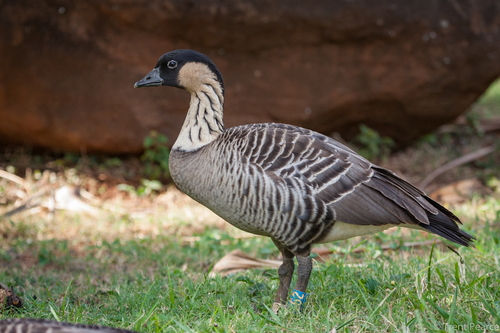
Hawaiian Goose
The Hawaiian Goose, or Nene (pronounced 'nay-nay'), is a unique and culturally significant bird endemic to the Hawaiian Islands. It is the world's rarest goose and is believed to have evolved from Canada Geese that arrived in Hawaii around 500,000 years ago. As the state bird of Hawaii, the Nene plays a vital role in the islands' ecosystem, primarily as a seed disperser. It holds cultural significance for Native Hawaiians, appearing in folklore and representing a connection to the land.
55-71 cm
Length
Not Evaluated cm
Wingspan
Vulnerable
Conservation Status
Distribution
Historically found on most of the main Hawaiian Islands, the Nene is now primarily found on the islands of Hawaiʻi, Maui, Molokaʻi, and Kauaʻi. Reintroduction efforts are ongoing. They do not typically migrate long distances, although they may move between different elevations within the islands.
Lifespan
Up to 24 years in the wild, and potentially longer in captivity.
Hawaiian Goose's Habitat
Habitat Types
Grasslands, Shrublands, Volcanic slopes, Coastal dunes, sparsely vegetated lava flows
Climate Zones
Tropical, Subtropical
Adaptations
Nene have evolved reduced webbing on their feet compared to other geese, an adaptation to traversing the rough lava fields. They also have strong legs and padded toes for walking on the rocky terrain.
Variations
No recognized subspecies exist, but there can be slight variations in size and coloration between island populations.
Appearance
Breeding Plumage
Plumage is similar year-round.
Seasonal Feather Changes
No significant seasonal variations.
Sex Based Plumage Differences
Males and females have similar plumage, characterized by black faces, caps, and hindnecks, buff cheeks, and deeply furrowed neck feathers with distinctive black and white barring.
Notable Features
Reduced webbing on feet, Strong legs and padded toes, Distinctive black and white barring on the neck
Diet and Feeding
Primary Foods
Grasses, Leaves, Seeds, Berries, Flowers
Foraging Behavior
Nene are primarily grazers, feeding on vegetation in grasslands and open areas. They also browse on shrubs and low-lying plants.
Specializations
Their bill is adapted for grazing on short grasses and other vegetation.
Seasonal Diet Variations
Their diet may vary slightly depending on the availability of different plant species throughout the year. During drier periods, they may consume more drought-resistant plants.
Behavior
Social Structure
Nene are generally found in pairs or small family groups, but can form larger flocks outside of the breeding season.
Communication
Soft, nasal 'nay-nay' calls, Hissing when threatened, Visual displays, such as head-bobbing
Migration
Nene are non-migratory in the traditional sense. They may make short-distance movements between feeding and nesting areas within the islands.
Territorial or Group Behaviors
Pairs defend their nesting territories during the breeding season. Outside of breeding, they can be relatively social.
Conservation
Threats
Habitat loss and degradation, Introduced predators (e.g., mongooses, cats, dogs, rats), Vehicle collisions, Historical hunting, Inbreeding due to small population size
Protection Programs
Captive breeding and reintroduction programs, Predator control, Habitat restoration, Public awareness campaigns, Establishment of protected areas
Local National Laws
Protected under both U.S. federal law (Endangered Species Act) and Hawaii state law.
Population Trend
Increasing, due to intensive conservation efforts.
Population Estimates
Approximately 2,500-3,000 individuals.
Interesting Facts
Nene are the only surviving species of goose endemic to the Hawaiian Islands.
Several other goose species once existed in Hawaii but went extinct after human colonization.
They are believed to have evolved from Canada Geese.
Genetic studies suggest a close relationship between Nene and Canada Geese.
Nene have less webbing on their feet than other geese.
This adaptation is beneficial for walking on the rugged lava terrain of their habitat.
The nene population once dwindled to just 30 birds in the 1950s.
Captive breeding programs were crucial in preventing their extinction.
Faqs about Hawaiian Goose
What is the biggest threat to Nene?
Introduced predators, such as mongooses, cats, and dogs, pose a significant threat to Nene eggs, goslings, and even adults.
What can I do to help Nene?
Support conservation organizations working to protect Nene, keep a safe distance from Nene in the wild, and avoid feeding them. Drive carefully in Nene habitat, especially during the breeding season.
Are Nene aggressive?
Nene are generally not aggressive towards humans, but they may defend their nests or young if they feel threatened. It's important to give them space and observe them from a distance.
Can Nene fly?
Yes, Nene can fly, although they spend a significant amount of time on the ground. Their reduced webbing and strong legs are adaptations to a more terrestrial lifestyle compared to other geese.
Copyright @ Nature Style Limited. All Rights Reserved.
 English
English